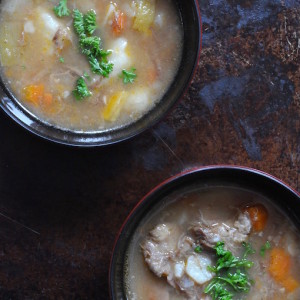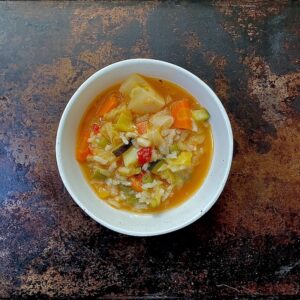Tomato Soup
Of all the recipes a well-intentioned person can offer, soup is perhaps the most difficult to quantify.

Laurie Colwin famously wrote about this in the essay “Soup,” found in Home Cooking. For the three people left on the planet who haven’t read Colwin, in brief, she describes soup as naturally “eccentric,” adding “No two are the same.”
Colwin goes on to describe the best soup she ever ate, made from pheasant, potatoes Anna, peas, cabbage, and stock. This soup was concocted by a friend using up her Christmas leftovers. It was impossible to replicate. Colwin tried.
This brings me to Barbara Kafka, author of the excellent Soup: A Way of Life. In addition to useful instruction and recipes, Soup features recollections of family and friends, including James Beard and Barbara Tropp.

Kafka’s introduction includes a brief paragraph entitled “vagueness.” In it, she explains soup is a forgiving food that won’t be wrecked by a bit more or less of an ingredient.

—
Into the kitchen.
Tomatoes aren’t fresh right now, unless you buy flavorless baseballs from the southern hemisphere. (Or you inhabit the southern hemisphere, in which case, ignore the following.) Now is the time to use home-canned tomatoes, or to purchase a quality commercial brand.

I’ve made this soup with canned crushed tomatoes and whole Roma tomatoes. I prefer whole Romas, but both are good. The choice is yours.
There are people who claim delicious soup is possible using water as a base. My attempts at water-based soups were dismal failures, so either these people are better cooks than I am or they’re lying. Whatever the case, I strongly suggest making tomato soup with a broth base. Said broth may be chicken, vegetable, or the liquid from your canned tomatoes.

Nitpicky readers may be annoyed by my using “broth” and “stock” interchangably. I am a self-taught cook from Detroit, not a CIA graduate (the cooking school, not the government agency). I could hunt down the differences in definitions, but then this post would get longer. So let’s move on.
Most soups are improved by a mirepoix, French for a mixture of chopped onion, carrot, and celery, which is gently cooked in butter, or, in this case, butter and olive oil. This tomato soup was prepared just after Christmas. Stores were closed. I had one carrot, onion, and garlic. So I made do.

Sweating vegetables is like browning beef: you can omit the step, but it’s easy to do and improves the final dish. To sweat vegetables, melt a little butter with some olive oil (olive oil stops the butter from burning). Add the vegetables, stir them around, and partially cover the pot. Cook gently, stirring occasionally, 5-7 minutes. The vegetables should soften rather than brown. If the pot starts drying up, add more butter, olive oil, or water.

Once the vegetables have softened, add the tomatoes and their liquid, the chicken broth, salt, pepper, smoked paprika, and a tiny pinch of hot pepper flakes.
I added a shot glass of dry Marsala. This is optional. So optional that there’s no photograph. Instead, a totally unrelated shot of a florist’s window in Berkeley.

If you want to include root vegetables in the soup, add them now. Either way, bring the tomato soup to a simmer. Let it cook for at least an hour. After an hour, add leafy vegetables like spinach, baby kale, or chard leaves.

You can add lentils, rice, or pasta to the soup either midway through cooking or 45 minutes before serving. If you add the starches at the midway point, they will expand, thickening the tomato soup. They’ll also drink up some broth, which isn’t a bad thing. Just know you’ll need to add either more broth, more water, or both.

Tomato soup needs a fair amount of salt and pepper; season generously. You might also want to add a squeeze of lemon at the end of cooking time.
A final note….
Leftover cooking juices from roasts, fat and all, may be frozen and saved for moment like this. I had about a quarter cup (60ml) of cooking juices from our Christmas dinner of veal steaks. Defrosted and tipped into the soup, they made a subtle yet flavorful addition.

Not beautiful. But tasty.
Tomato Soup is a meal in itself, needing nothing more than good bread alongside.

Tomato Soup
Serves: 6-8
Prep time: 10 minutes
Cooking time: tomato soup can be ready in two hours, but is best when slowly simmered for at least three. This is largely unattended cooking time. Tomato soup may be also be prepared using a pressure cooker, Instant Pot, or slow cooker.
As noted above, soup recipes are by nature imprecise. You may need to add more or less liquid to your pot. Please taste throughout cooking to ensure adequate seasoning. See notes, below, for variations.
I made this soup in a lidded 8 quart/liter soup pot.
1-2 tablespoons olive oil
1-2 tablespoons unsalted butter
1-2 carrots, scrubbed if organic, peeled if not, cut into coins
1 medium onion or shallot, peeled and sliced into half moons or any shape easily eaten from a spoon
1-3 garlic cloves, crushed, peeled, and minced
1-2 sticks celery, rinsed and sliced (optional)
one 28 ounce/822 grams or two 14 ounce/411 grams whole tomatoes in juice or crushed tomatoes in juice, unsalted
4-6 cups/945 ml-1420 ml unsalted chicken or vegetable broth
2 teaspoons salt
2 teaspoons pepper
1/2-1 teaspoon smoked paprika
tiny pinch hot red pepper flakes
shot dry marsala (optional)
Approximately 4-5 ounces/60 grams Basmati or other rice
Approximately 4-5 ounces/60 grams red lentils
Approximately 4-5 ounces/60 grams orzo or other soup pasta
Approximately 4-5 ounces/60 grams frozen peas
A few handfuls fresh greens, washed and shredded; I used
baby kale, spinach, and parsley, washed, patted dry, trimmed, and chopped
Approximately 4-5 ounces/60 grams minced ham (optional)
Optional, at the table: sour cream or creme fraiche.
Melt the butter and olive oil in the pot over low heat. The bottom of the pan should be generously coated.
Add the carrots, onion, garlic, and celery, if using. Stir to coat in butter/olive oil and cook gently, partially covered, 5-7 minutes. Vegetables should soften, not brown or fry. If the pot begins drying out, add more butter/olive oil or water.
Once the vegetables have softened a bit–look for the onion to be transluscent–add the canned tomatoes and their juices to the pot. If you are using whole tomatoes, break up them up a bit with a fork, knife, or your very clean hands.
Add the broth to the pot. Stir.
Add the salt, pepper, smoked paprika, and hot red pepper. Add the Marsala, if using.
Bring the tomato soup to a gentle simmer, and keep it simmering for about an hour. If you struggle to keep the burner at even temperature, a flame tamer is calling to you.
Stir occasionally.
After an hour, taste for salt; the soup will likely need quite a bit. Now is the time to add any additional vegetables, like the greens listed above. If you want a thick soup, add lentils, rice, peas and/or pasta now.
The tomato soup can now simmer largely unattended for another 1-3 hours, provided you give it an occasional stir. It may need topping up with a bit of water–about 1/4 cup/60ml.
If you want a thinner soup and plan to add lentils, rice, peas etc, add them 45 minutes before serving time.
Serve tomato soup in deep bowls, accompanied by crusty bread. Sour cream or creme fraiche is nice but not necessary.
Tomato soup keeps, refrigerated, 3-5 days. To keep longer, heat to boiling, cool, and refrigerate again.
Tomato soup will keep in a freezer-proof container up to three months.
Notes/theme and variation
Lacking chicken or vegetable broth, use the juice from the canned tomatoes. If you have tomato paste, add 2 tablespoons.
As noted in the post, lentils, rice, and soup pasta or orzo may be added midway through cooking or about 45 minutes before serving. If you add the starches midway, they will thicken, creating a thick soup. You will need to add more liquid during cooking to compensate. This can be broth, additional tomato, or water.
The ham was requested by my husband. The soup is good without it.
Tomato soup is infinitely variable. Top it with a spoonful of sour cream or creme fraiche. Add cubed, peeled potatoes instead of the small pasta. Add another type of pasta. Take the soup in a Southeast Asian direction by seasoning with coconut milk, red lentils, rice, star anise, lime, fish sauce, white pepper, brown or palm sugar and dried hot red pepper. Chop boneless skinless chicken thigh or breast for a heartier dish and add it to the hot soup, allowing it to cook in the hot broth (make sure it’s cooked through!)
For a first course dish, leave the tomato soup plain. Just before serving, crack an egg into each bowl. Ladle the hot soup over and stir rapidly.
Fresh black beans may be added to the soup (or canned), along with two teaspoons of crushed cumin, minced fresh cilantro (to taste), thinly sliced radishes (yes, add them to the soup) and a shot of tequila. Serve with fresh avocado, sour cream, and tortillas. And no, this is hardly authentic Mexican food.





